



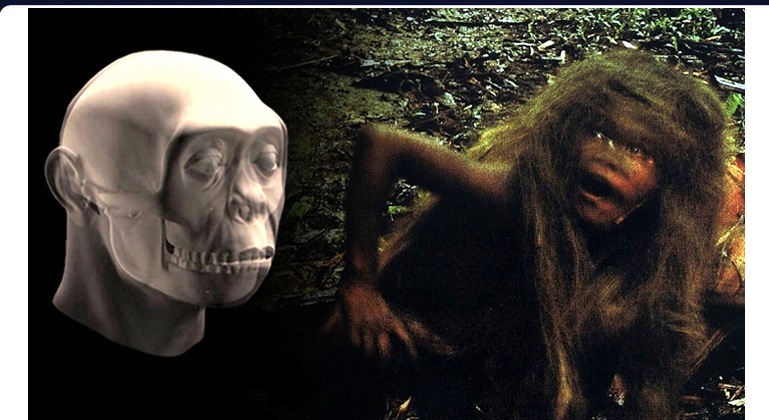
Resonance in Exoplanetary Hybridization
Humans, Hobbits & Gnomes: Revealing Hybrid Genetics
by Alex Putney for Human-Resonance.org
July 29, 2015
Indigenous Elders in all parts of the world possess ancestral knowledge of elusive species of 'little people' --mischievous hobbits and gnomes that dwell in caves and must forage and hunt for food above ground.
Called kakamora or chowa-chowa throughout the lush tropical rainforests of the Solomon Islands, this species is known to local trackers as inhabiting remote and inaccessible areas not afflicted with the human presence. A significant population of these diminutive troglodytes has been widely recognized as occupying a multitude of caves on the remote and sparsely populated inland mountains of Makira.

Islanders say the kakamora live a naked and barefoot lifestyle, customarily allowing their hair to grow down past the waist and loosely matted or dreaded into several locks that hang down over the body for warmth, camouflage and rain protection. It is also said they do not use fire, but "like to snatch brands from native fires, and play with them... throwing them carelessly aside".
Just as described by eyewitnesses, a surprised kakamora female was caught igniting a dry palm frond on a small campsite fire in a remarkable photograph taken by Victoria Ginn on Makira in 2004 (above).
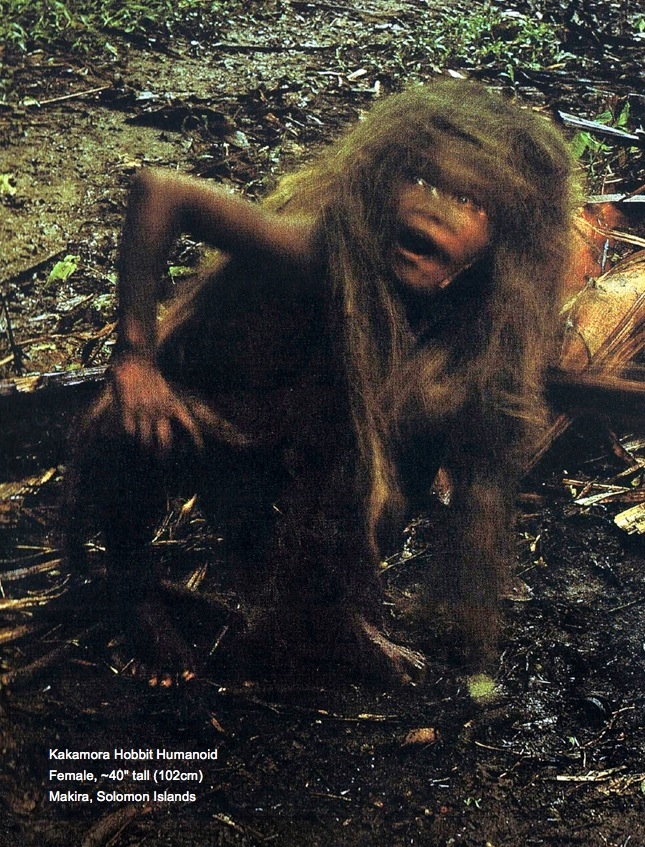
Inspection of the photograph reveals a young, dark-skinned female hobbit with a flat face, heavy brow and sloping forehead. Her low hairline is formed by matted, sun-bleached blonde/brown hair that partly covers her body. In contrast to human anatomical norms, this female hobbit displays disproportionately robust forearms and wrists matching her very large hands and feet.
Ethnographers reported on the native lore concerning the kakamora in a survey entitled 'Beliefs and Tales of San Cristoval' (Fox & Drew, 1915):
They vary considerably in height, from 6" (15cm) to 3 or 4' (91-122cm)... They also vary in [skin] color from very dark to quite fair. Most of them are considered to be quite harmless, but sometimes they have been known to attack men. When they do so they use their fingers, which are furnished with long sharp nails with which they stab.
They have no weapons of any sort, build no houses, plant no gardens, and have no arts. They wander about the forest eating nuts, ripe fruit, and opossums: the last they are fond of. Sometimes men have come across two of them, one at the top of a tree throwing a dead opossum to his mate. They are exceedingly strong; one is said to be as strong as 3 or 4 men. They live in [burrowed] holes and caves, and sometimes in banyan trees. They are exceedingly fond of dancing, and many of their dancing grounds are pointed out. They dance by moonlight and in heavy rain, and sing as they dance. They have a [spoken] language, but not like Melanesian languages.
They have long straight hair coming down to their knees. They have a king --in Mwala it is a queen. They know nothing about fire or cooking, but they like to snatch brands from native fires, and play with them, presently throwing them carelessly aside. Some of them are fond of deluding men. One plan is to beat another kakamora; men suppose it is a child crying, follow it, get lost in the bush, and are mocked by the kakamora from tree tops. They are naked, have very small teeth, and are afraid of anything white.

One hundred years after this clear cultural documentation was published, closely related research findings from all over the world confirm the global distribution of this tiny crypto-hominid. Island 'folklore' can now be confirmed as hard fact, easily affirmed by genetic studies of hobbit mass graves from Palau, Micronesia.
Thriving hobbit populations still exist today in remote mountainous and/or rainforest-covered areas of Melanesia, Micronesia, Indonesia, Australia, Tasmania, New Zealand, South American Andes, USA, etc... (above).
Aggressive group predatory behavior of this species also includes vicious attacks on solitary humans:
Kakamoras reportedly have a disgusting odor... speak [an] unintelligible language,... are timid and shy and in general considered harmless. But they may become very dangerous to stray children or other lonely travelers... --kakamoras may attack and stab with their sharp nails and eat their victim. There are also stories about unsuccessful attempts of kakamoras to steal children from villages. But if a lonely traveler feels that kakamoras are bothering him, it is enough to wave a white cloth and all these creatures are terrified and run away.
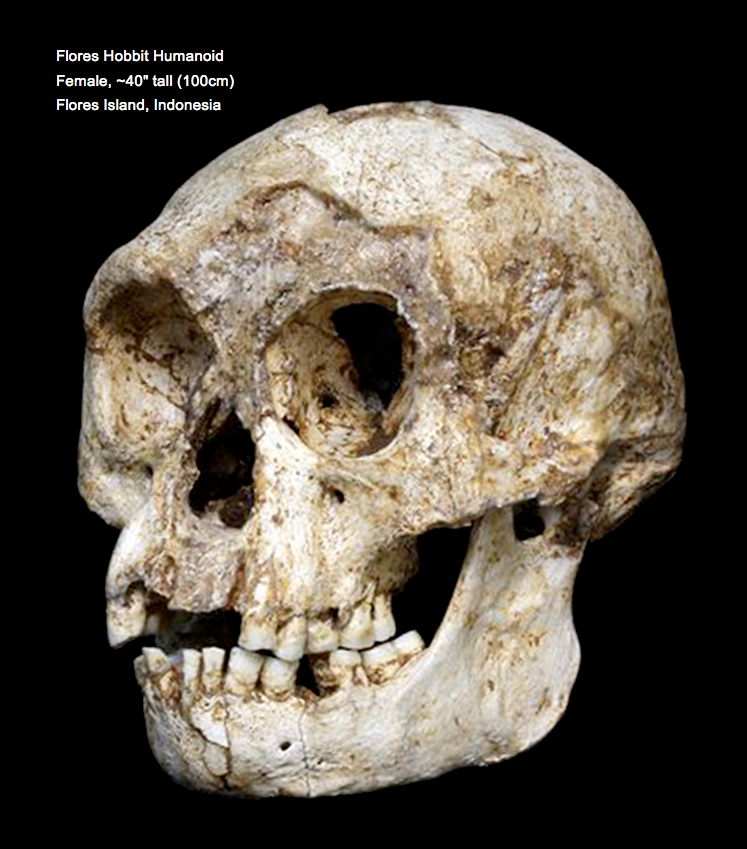
The most famous excavation of hobbit skeletal remains was conducted at a large cavern overhang Liang Bua, on the Indonesian island of Flores in 2003. The complete skull of a 3'6" tall (110cm) hobbit was recovered several meters below the soil surface and subsequently dated to ~18,000bp (above). Several other bone fragments and teeth from other similarly small humanoid skeletons immediately suggested the Paleolithic presence of a new hominid species that broke news headlines all over the world, followed by fierce scientific debate. Contentious claims have not been resolved for the lack of relevant DNA evidence.
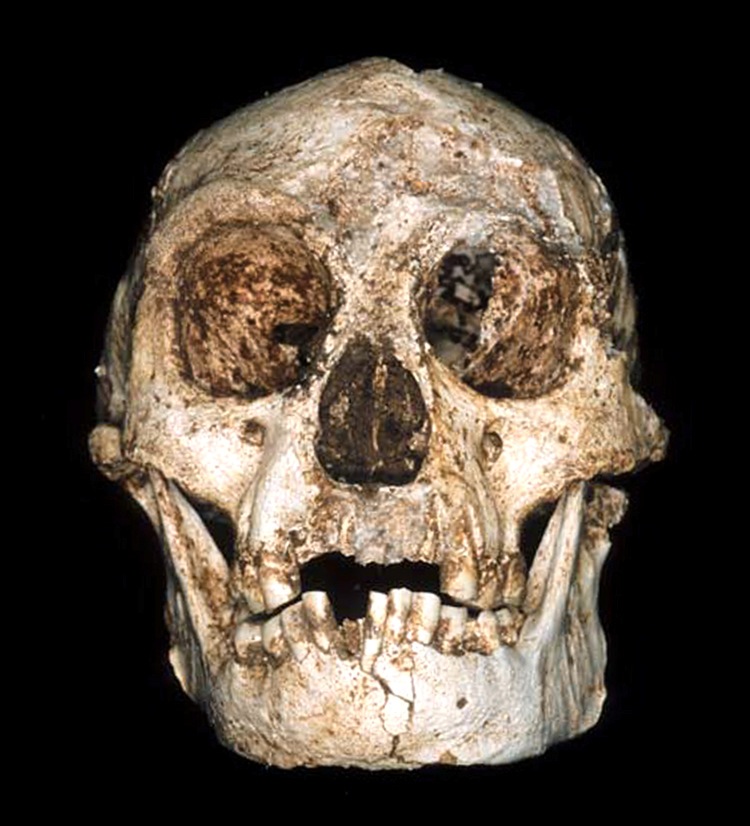
Heavily funded scientific groups widely denied the veracity of the discoveries, while the archeological department of the Indonesian government actually stole the skull specimen from the research team that made the discovery with the goal of obfuscating and delaying the results of morphological analyses.
Despite many fraudulent political maneuvers executed by the 'authorities', research on the small species continued until it was eventually named as a new species by the discoverers: Homo floresiensis. Use of fire by hobbits at Liang Bua is not consistent with living hobbit groups that do not demonstrate the skill.
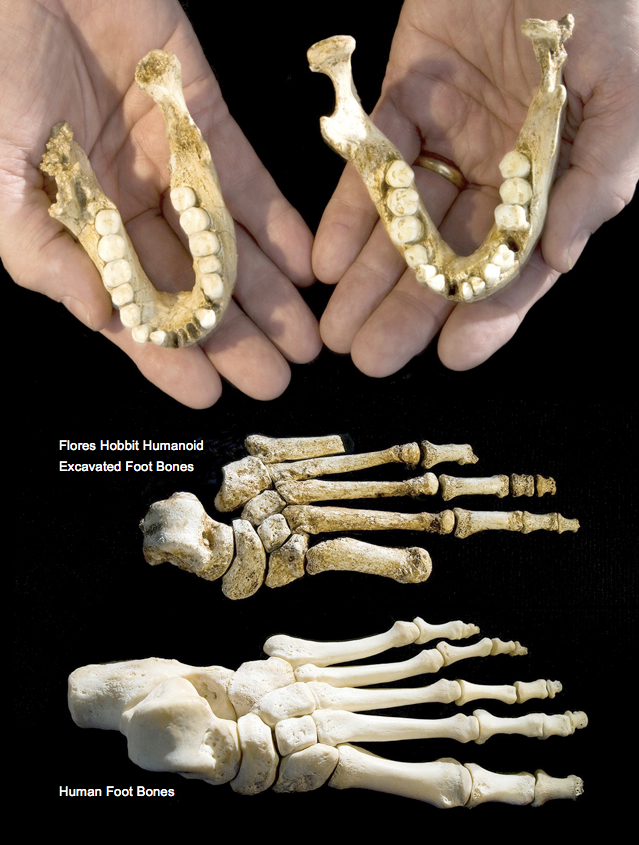
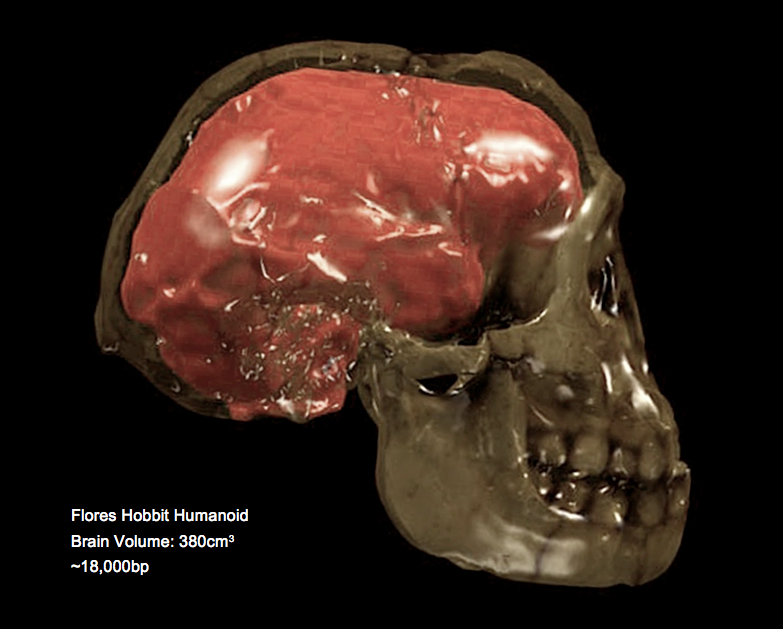
Species identification is based on many non-human skeletal characteristics described by the archeologists, with a tool culture of skilled flint napping enabled by an ample brain volume measured at 380cm3 (above). Rangers in Lampung, Indonesia reported sighting several living hobbits taking ripe fruit from a plantation:
Rangers patrolling the Way Kambas National Park (TNWK) in Lampung claim to have sighted dozens of pygmies in a number of areas across the park. According to them, the pygmies sport dreadlocks, measure no more than 50 centimeters tall and do not wear any clothing.
"A number of rangers claim the pygmies grow their dreadlocks down to their waist. The first sighting by the rangers was on March 17 at 6:40 p.m. local time," said TNWK spokesman Sukatmoko. "The rangers monitored their presence for around 15 minutes from a distance of around 35 meters. When the rangers were about to approach them, they immediately hid behind trees and vanished. They ran very fast," said Sukatmoko...
He added that on March 20, patrolling rangers sighted the pygmies again in the same place, but this time they observed from further away and for a shorter time. "We can record pictures of the pygmies at night. After it's proven they exist, we will immediately inform the Forestry Ministry, or even the President," he said... "We believe they really exist in TNWK. We're making strenuous efforts to find them. In the event that we do, we hope the government protects them. Our rangers have seen them with their own eyes, but have yet to take pictures of them," he said, adding the center had allowed academics and researchers to trace and study the group.
Indonesian Forum for the Environment (Walhi) Lampung chapter campaign director Mukri Friatna said the pygmies had been sighted in a number of forests in Indonesia, such as in Kerinci Seblat (West Sumatra), Liang Bua (Flores) and Bone (South Sulawesi).
"In Kerinci Seblat, they are known as the orang pendek [short people], in Flores as homo floresiensis, and in Bone as members of the Oni tribe. In Mount Kerinci, the creature is depicted as having inverted legs but is very agile among the dense foliage," said Mukri.
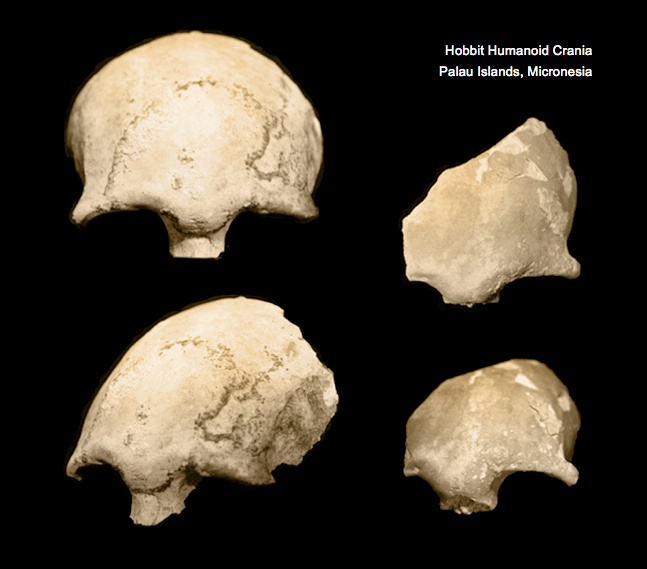
All photographs obtained by Way Kambas park rangers were confiscated by the Indonesian government. In 2006, archeological finds in caves on Palau Island, Micronesia identified hobbit mass gravesites (Berger et al., 2006) . Cranial fragments were described and dated with other bones to ~940-2,890bp (above).
Very similar cranial fragments were excavated by Neil Steede in Ohio, in the American midwest (below). Once again, abundant evidence of advanced tool-making cultural activities were excavated with the two cranial fragments. Hobbit-manufactured microliths included refined obsidian biface blades and arrowheads.
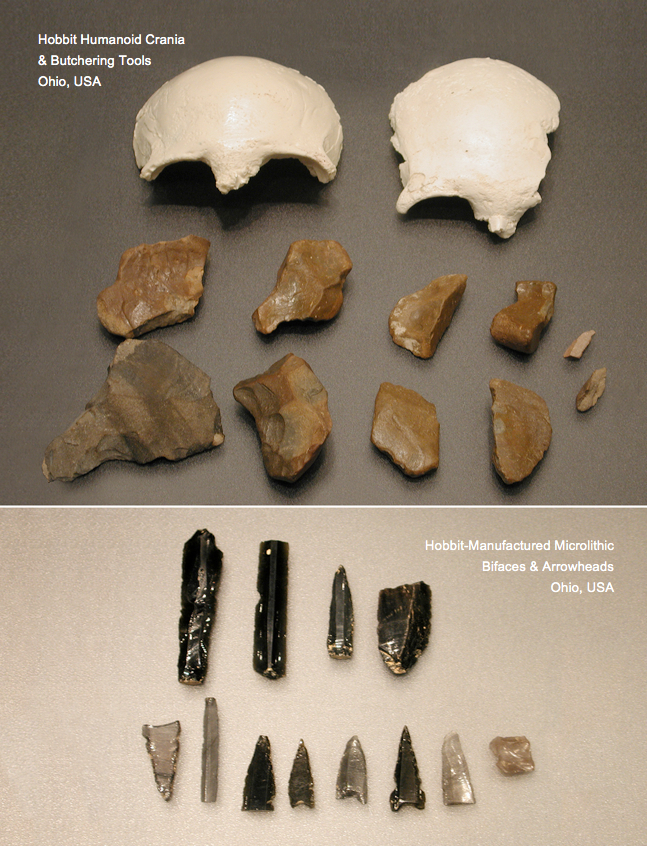
Further physical evidence of small tunnel networks extending below the bedrock of the Hawaiian Islands are known to natives as stoneworks of the Menehune hobbits. A 5,000-year-old hobbit town, called Makhunic, was excavated in Iran, yet all associated skeletal remains were confiscated by the govenment.
Globally distributed, hobbits are most likely a hybrid species derived from artificial insemination of human surrogate mothers from various regions with gnome semen. If DNA evidence supports this conclusion, this newly recognized human hybrid species deserves renaming as Homo sapiens gnomus.
Perhaps the most remarkable and well documented historical event involving the hobbit species occurred only 56 years ago, and is still being recounted by scores of living eyewitnesses during annual celebrations that commemorate the day of January 4, 1959 throughout the Congo; marking liberation from colonial rule as prophetically predicted by the West African spiritual adept Simeon Toko ten years prior:
On 22 October 1949, Simeon Toko and 3,000 of his companions were put into two different jails, Ofiltra and Ndolo. After three months in the jails, a decree was passed to deport them out of the country. This is when Simeon Toko started revealing Himself.
The Belgian administrator of the jail in Ndolo was named Pirote. He abused the "Tokoist" prisoners, hurling racist insults. He always ended with: "Filthy nigger, you're going back to nigger country in Angola!"
Tired of this abuse, Simeon Toko replied sharply to Pirote: "Know that if there is a stranger here, it is you! To show you that I am home, the day you make the injustice of deporting me from Belgian Congo, I'll have you carrying my bags alongside me!" Simeon Toko held up both hands, spread out his fingers, and told the abusive Belgian to count them. He said: "I give 10 years to the Belgians, not one more or less, to leave this country!"
No one at that time comprehended these sibylline words. However, the disciples of Simeon Toko understood later: the day they were deported, Pirote fell dead. He was gripped with an apparent heart attack while working in his office, and died as suddenly as though a bullet had struck him squarely.
As for the other mysterious statement made by Simeon Toko: 10 years later, in 1960, the Belgians were obliged to leave their rich colony of Congo. But to impel this event, Simeon Toko "unleashed his army"... The event was witnessed by thousands of people on 4 January 1959. Some of the author's own relatives were there, but so are there thousands of citizens of the city of Kinshasa, who witnessed it on that day, alive at this writing. January 4th is now a public holiday in Kinshasa and commemorates this event.
Kinshasa was called Leopoldville. On that day, the "Cherubim and Seraphim" appeared and stood against the Belgian colonial army. The citizens of Leopoldville saw an army of about a thousand very small men, about the size of children or dwarfs, with very muscular, imposing bodies.
Each of these diminutive human-looking creatures showed great strength; for example, a witness saw one of them flip a five-ton truck over with one arm! The Belgian soldiers fired at these little brown angels to no effect. Terrified, the colonial army was thrown into confusion. The little men disappeared as suddenly as they had appeared. One year after this amazing mass apparition, the Democratic Republic of Congo was a new and independent country.
While no concise description of the dwarf humanoid species is given, distinct cultural habits of the hobbits includes going completely naked and barefoot, covered only by large, matted dreadlocks. Displays of astounding individual strength and force of numbers by surprise were entirely successful in driving the colonial soldiers off in hysteria, while reports of bullets having no effect on the hobbits suggests these warriors answering the call of Simeon Toko were trained in the advanced qi arts of EM field control. These arts are still practiced by secretive Asian traditions, such as the Javanese Mo Pai school of John Chang.
The events of January 4, 1959 confirm the subsurface presence of ancient hobbit populations living below West Africa, inhabiting extensive cave systems with artificial lighting engineered before the fall of the Atlantean civilization. Once again, documentation of a superstrong dwarf race of African hobbits directly implicates artificial interspecies hybridization of African human females with gnome paternal heritage.
Other traditional stories relating the existence of the smaller dwarf humanoids --not hobbits, but gnomes-- are widely shared among indigenous cultures in areas of the world where these diminutive folk reside below ground. Lore surrounding the Leprechauns of Ireland abound with mischievous behavior including their ability to suddenly disappear in plain sight. This sounds like the very same situation surrounding the sasquatch, where advanced technological capabilities are being used to befuddle terrestrial humans.
Native American cultural knowledge concerning the existence of superstrong gnome humanoid species living below their lands mirrors much of the Leprechaun lore from across the Atlantic, and describe tiny gnomes ~1-3' height (~30-91cm) capable of vicious attacks using sharp teeth, long nails, great agility, quickness and wielding bows with poison arrows to deter any invaders:
In 1804, the Lewis and Clark Expedition stayed for a time with a band of Wichiyena Sioux on the Vermillion River in modern-day South Dakota. On August 25, Meriwether Lewis, William Clark, and 10 other men traveled about 9 miles (14 km) north of the river's junction with the Missouri River to see the "mountain of the Little People". Lewis wrote in his journal that the Little People were "deavals" (devils) with very large heads, about 18 inches (46 cm) high, and very alert to any intrusions into their territory. The Sioux said that the devils carried sharp arrows which could strike at a very long distance, and that they killed anyone who approached their mound. The Little People so terrified the local population, Lewis reported, that the Maha (Omaha), Ottoes (Otoe), and Sioux would not go near the place. The Lakota people who came to live near the "Spirit Mound" after the Wichiyena Sioux have a story no more than 250 years old which describes how a band of 350 warriors came near the mound late at night and were nearly wiped out by the ferocious Little People (the survivors were crippled for life)...
Crow folklore says the "Little People" live in the Pryor Mountains, a small mountain range in Carbon County, Montana. Petroglyphs on rocks in the mountains, the Crow said, were made by these demon-like creatures. Because the Little People live there, the mountains are sacred to the Crow. The Little People are said to be no more than 18 inches (46 cm) (or knee) high. Crow folklore differs slightly from that of other tribes in describing the Little People of the Pryor Mountains as having large, nearly round bellies; incredibly strong but short arms and legs; and little or no neck. In the story of "Lost Boy" (or "Burnt Face"), the Crow told of a Little Person who killed a full-grown bull elk and carried it off just by tossing the elk's head over its shoulder. The Crow expression, "strong as a dwarf," references the incredible strength of these Little People. However, they are incredibly fierce warriors, feed primarily on meat, and have many sharp, canine-like teeth in their mouths. Nearby tribes told stories of the Little People tearing the hearts out of their enemies' horses, stories which may have helped keep these tribes from making war on the Crow. Each year, the Crow made an offering to the Little People at Medicine Rocks (also known as "Castle Rocks"), where they believed some Little People lived. The Pryor Mountains Little People were also known for stealing children, food, medicine, and tobacco.
Another source offers a summary of various archeological finds of the 19th century related to the remains of gnomes recovered in the United States, the most important of which is a vast graveyard of gnome skeletons that was published by the Anthropological Institute in 1876, and kept from public awareness:
One report notes, however, that the skeletons and mummies of Little People (whatever they might be) have been found as far north as the Yellowstone River and as far south as the Wyoming-Colorado border. Another mummy was found in a cave in the early part of the 20th century near Pathfinder Dam (near Casper, Wyoming), and a few years later another mummy and six small skulls were found nearby.
As of the late 20th century, some Crow remained convinced that the Little People exist. Members of the Crow Nation passing through Pryor Gap sometimes still leave offerings for the Little People. Members of the modern Crow Nation say they have even encountered them while hunting in the Pryor Mountains. Others, taking a wrong road or footpath, say they have seen them blocking the road, and Little People are claimed to have even healed some sick people. Several white people in the area also claim to have seen the Little People, including a local bar owner, ranch hands, and hunters.
Other alleged discoveries, like that of the 1876 discovery of a "pygmy" graveyard in Coffee County, Tennessee, has some people saying that a race of pygmy people ranged all over the United states, and they often use Pedro the mummy as the proof. A man plowing his field supposedly found graves that were 2 feet long, 14 inches wide, and 18 inches deep. Other explanations have been offered for the burials, that they were of children or disarticulated people. The Cherokee had a legend of Little People who lived in mountains, came up to an average sized persons knee and were quite nice unless you disturbed their homes. There are many Native American stories about Little People.
According to William R Corliss in 'Ancient Man: A Handbook of Puzzling Artifacts', Sourcebook Project, 1978, citing the Anthropological Institute, Journal, 6:100, 1876: An ancient graveyard of vast proportions has been found in Coffee county. It is similar to those found in White county and other places in middle Tennessee, but is vastly more extensive, and shows that the race of pygmies who once inhabited this country were very numerous. The same peculiarities of position observed in the White County graves are found in these.
The writer of the letter says: "Some considerable excitement and curiosity took place a few days since, near Hillsboro, Coffee county, on James Brown's farm. A man was ploughing in a field which had been cultivated many years, and ploughed up a man's skull and other bones. After making further examination they found that there were about six acres in the graveyard. They were buried in a sitting or standing position. The bones show that they were a dwarf tribe of people, about three feet high. It is estimated that there were about 75,000 to 100,000 buried there. This shows that this country was inhabited hundreds of years ago."
Smaller than hobbits, gnomes are an omnivorous animal-like species of dwarf hominid also living secretly below ground, clustered in inaccessibly mountainous and/or rainforest areas throughout the world. In 2011, game hunters shot and mortally wounded a foraging gnome in the forests of Ohangwena, Namibia.
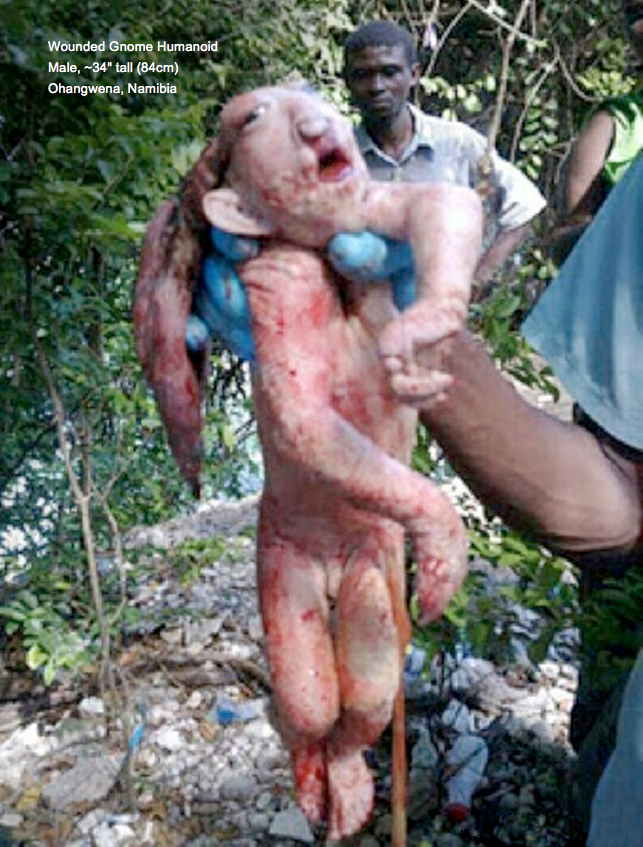
One clear photograph of the fatally wounded creature reveals the hairless body of a male of ~34" in height (86cm) with thick dreadlocks (above). Local police collected the corpse for forensic analyses that were not released publicly, but kept secret by the Namibian government. Why are they hiding gnome DNA?
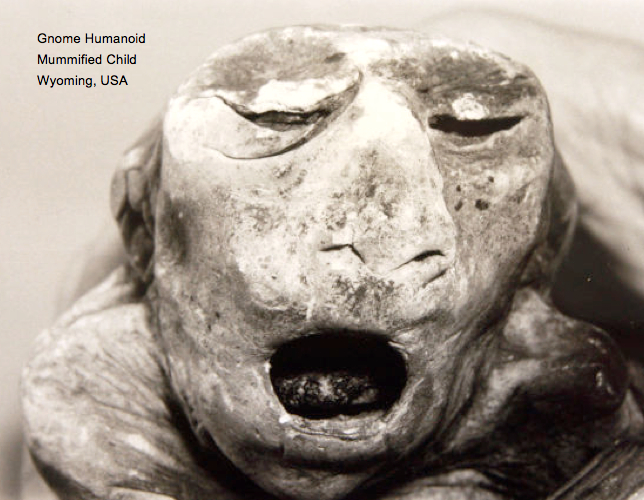
The many distinctly non-human features of this dwarf humanoid species of gnome that is notably smaller than the kakamora hobbits, are matched by tiny mummified humanoid remains collected by gold miners from narrow caverns below the Pedro mountains of Wyoming, in the rugged US northwest.
Nicknamed 'Chiquita', this mummified gnome was a female child of just a few years in age when it died (above), as indicated by the significant length of her hair (below). She presents a peculiar, wrinkled mouth --and virtually no neck or forehead whatsoever. Native wisdom of the Cheyenne tribe specifies these tiny humanoids as a subterranean race that has occupied their ancestral lands for millennia.
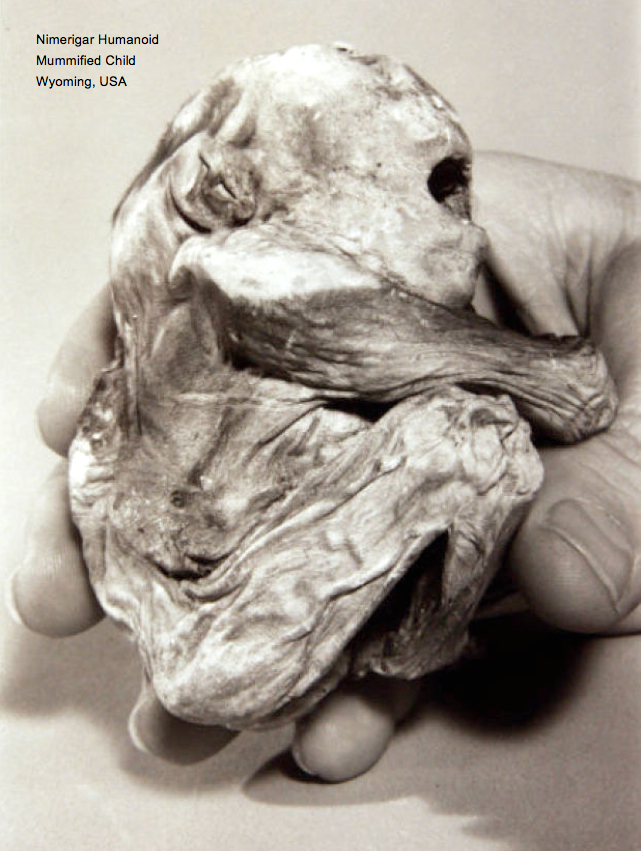
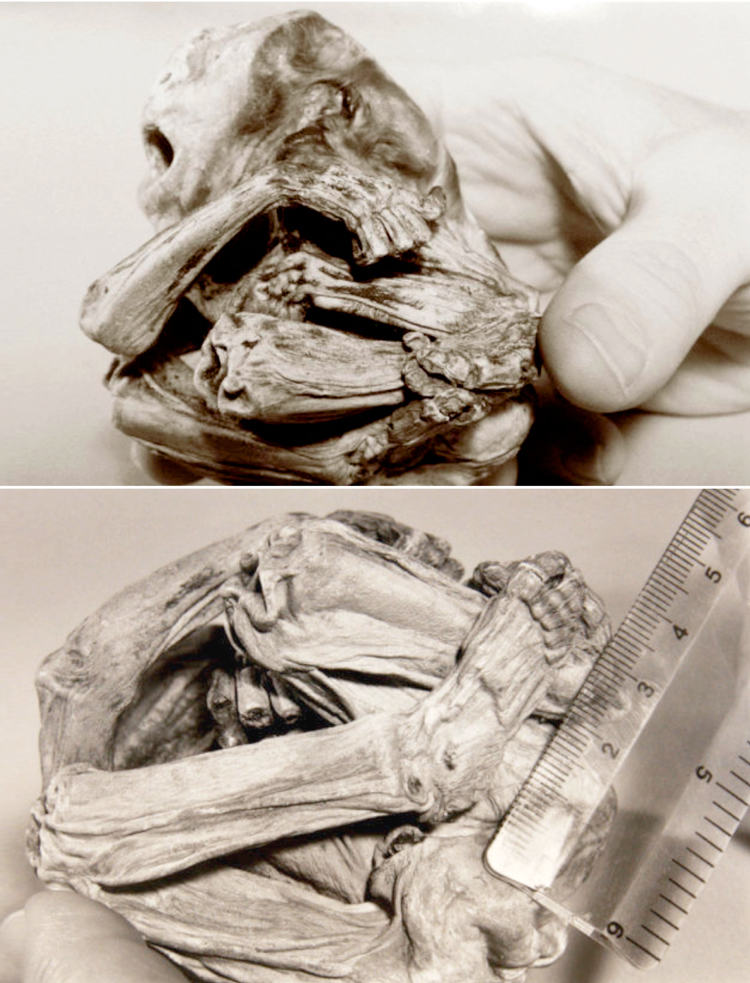
The Cheyenne call them nimerigar, or nimmi, etc... Elders relate that nimerigar prefer cave systems, but also burrow small tunnels into the soil and, among forest populations, often use hollows in large trees for disguising one of several linked entrances; quickly climbing up the home tree to escape danger. Another remarkable nimerigar mummy, nicknamed 'Pedro' after the mountain range, is a toothless elderly gnome that appears to have suffered a gruesome spinal injury before death by merciful rescuers (below).
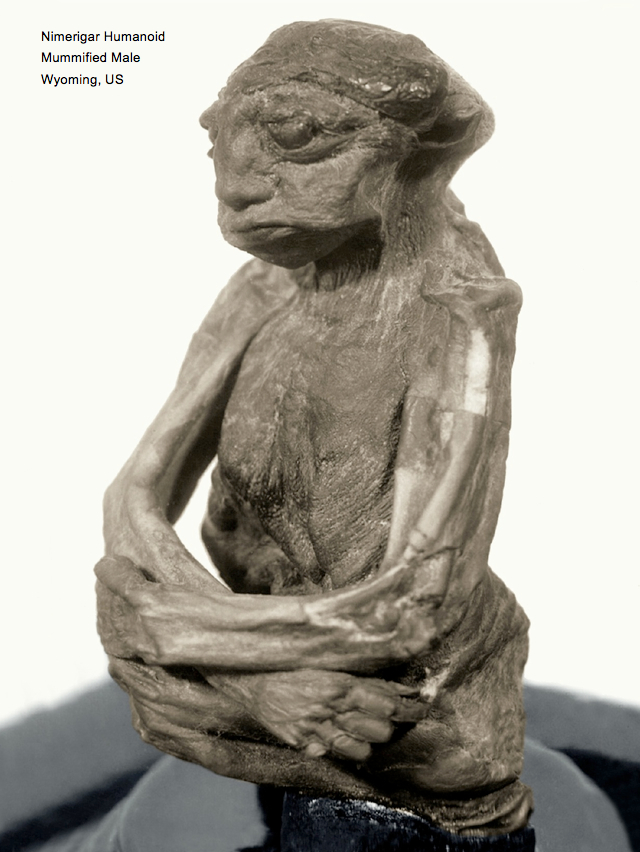
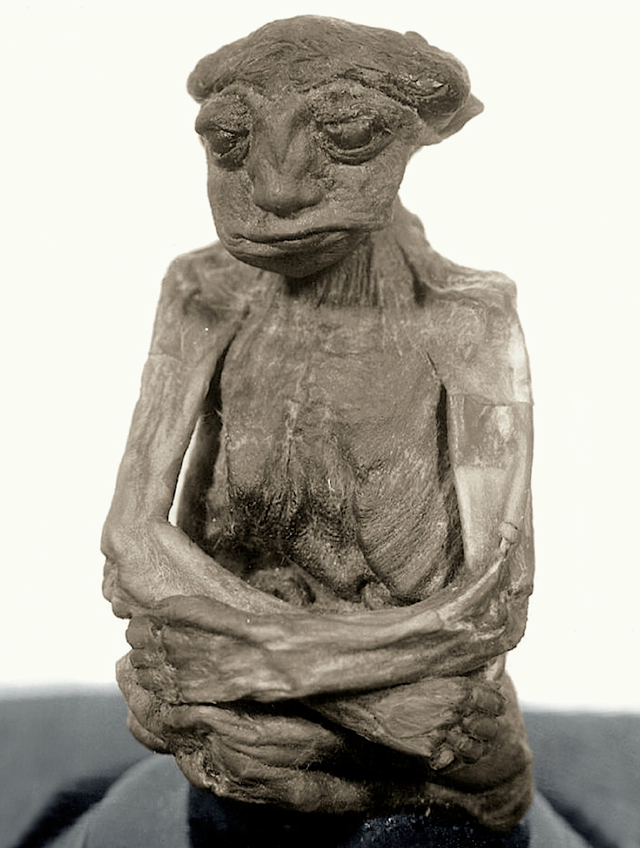
Any doubts concerning the authenticity of the Pedro mountains nimerigar mummies are totally obliterated by definitive x-ray scans of one of the tiny creatures, which present fine details of the gnome's unusual bone structure (below). While the individual apparently suffered a fatal fall, having a severely dislocated spinal column and pelvis, a final death blow was received to the top of the head that decisively ended his life.
While the collapsed skull fragments and lower extremities have distorted the humanoid's physical anatomy, many unique skeletal structures can be observed. Very thick vertebrae support an unusually thick, strong neck that connect to ribcage forms that are distinctly non-human.

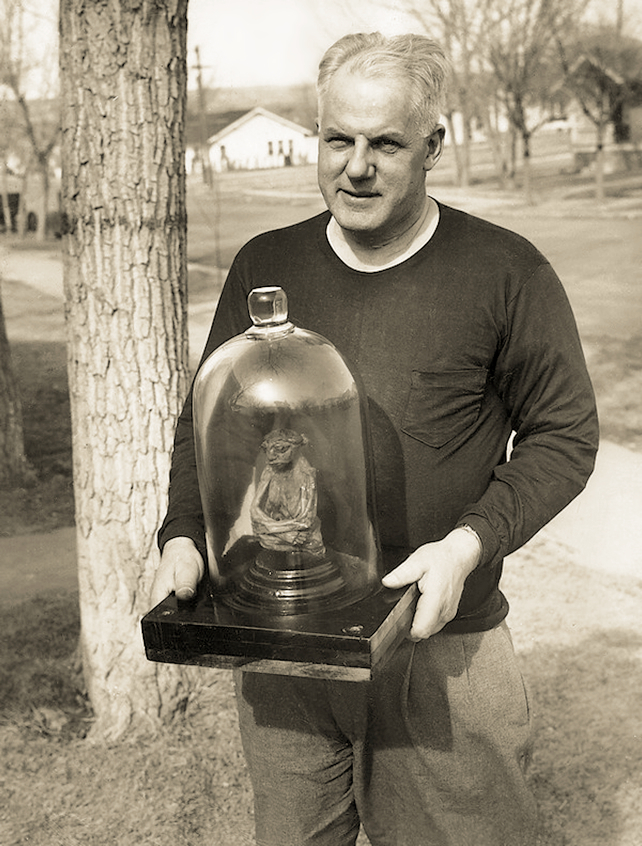
The nimerigar mummies known as 'Pedro' and 'Chiquita' were covertly purchased by government agents, since their documentation over a decade ago. Comparative morphological investigations of these perfectly preserved remains may offer an indication as to why this suppression has been so painstakingly undertaken. Surely, genetic testing of the specimens would provide definitive proof of authenticity for the nimerigar species, as well as offering insights into genetic relationships between the species and others.
Social integration of the miniscule nimerigar humanoids and the somewhat larger hobbits has been well established by hundreds of eyewitness accounts throughout Melanesia, as they are known to share cave habitations and cultural activities --typically living as one group. What is the basis of this odd partnership?
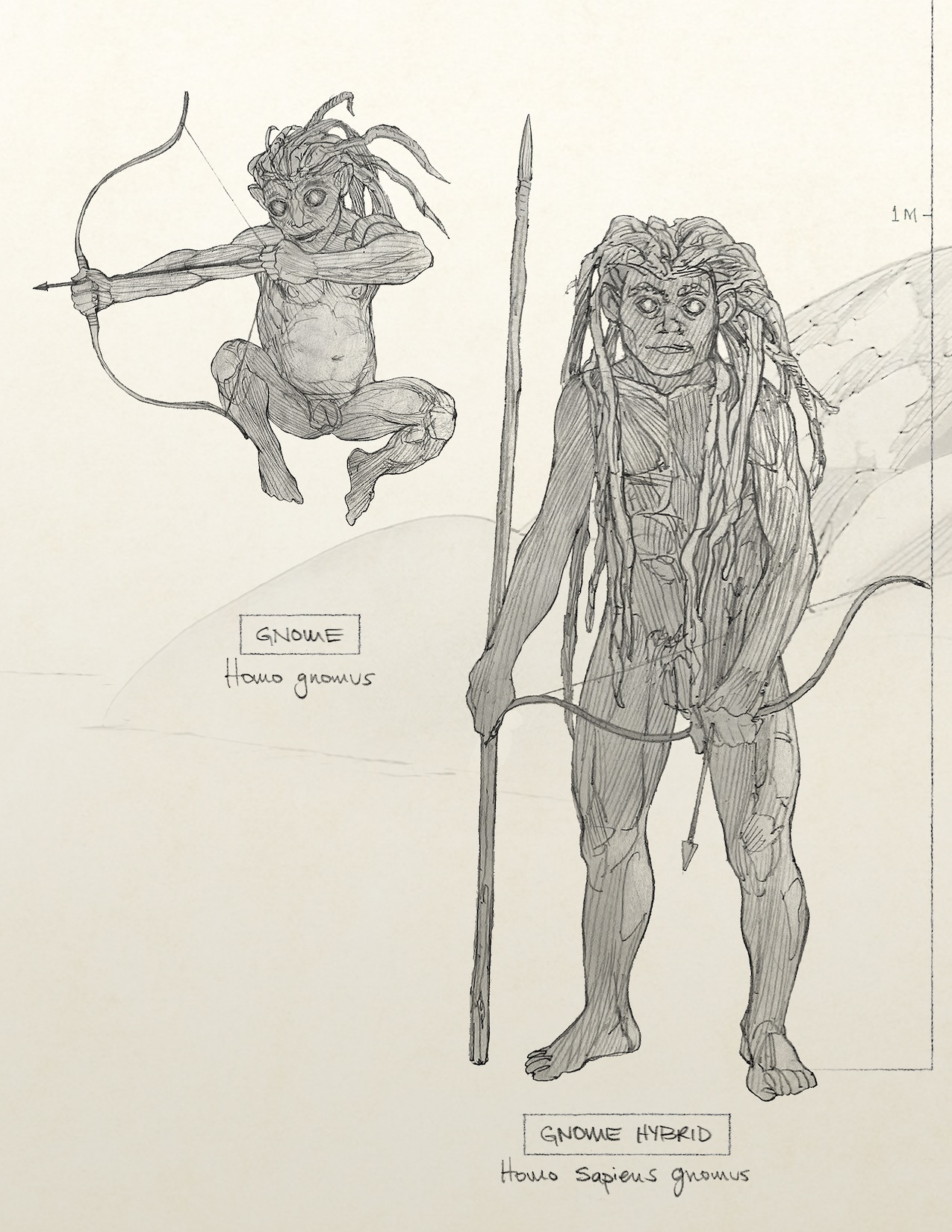
The full explanation for emerging interspecies dynamics between hobbits and gnomes will be elucidated by comprehensive whole genome DNA studies of the two small humanoid lineages. Identification of species phenotypes for both groups strongly indicates similar humanoid hybridization patterns prevalent throughout the Solomon Islands. Forthcoming DNA results will most likely reveal the smaller gnome species Homo gnomus was crossbred with humans by artificial means to create the hobbits --a hybrid species that would be more accurately described by a new designation-- Homo sapiens gnomus.
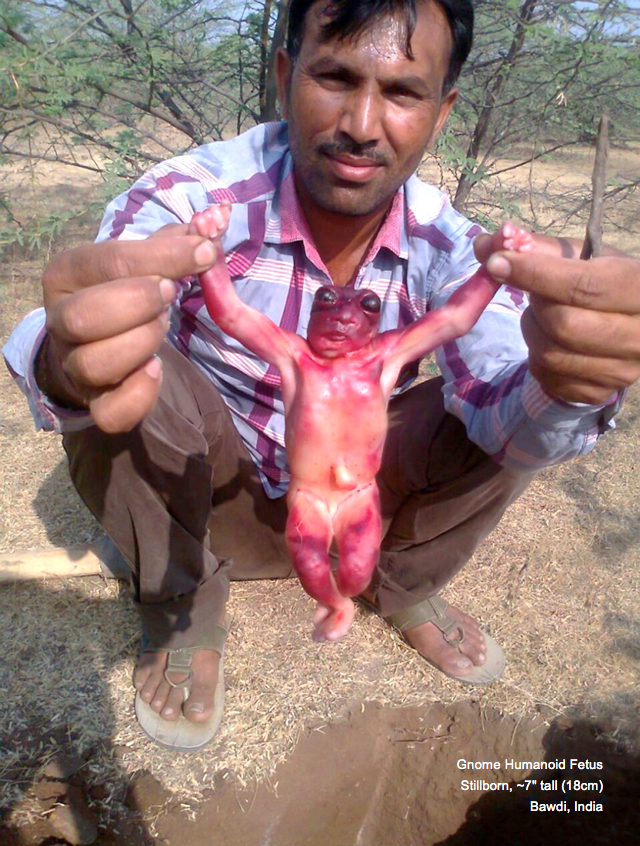
A surprising discovery made during excavations for a domestic project in Bawdi, India has astonished villagers. A small tunnel contained the fresh stillborn fetus of a gnome humanoid, ~7" in height (above). The humanoid's clean nails, clenched hands, red skin discoloration and freshly cut umbilical cord are indicative of a stillborn baby. The tunnels were apparently occupied by a breeding pair of gnomes.
Ongoing extraterrestrial experimentation with human reproduction involves use of females as surrogate mothers in exoplanetary hybridization programs. Genetic engineer-ing processes form a primary impetus for UFO abduction phenomena experienced worldwide for millennia. Our burgeoning awareness of this veiled reality emerges from the great public interest in bizarre reports of deformed dwarf hybrid babies born to horrified human mothers, as revealed by a recent case from the town of La Romana, Dominican Republic (below). Hypnotic regression often reveals the abduction events.
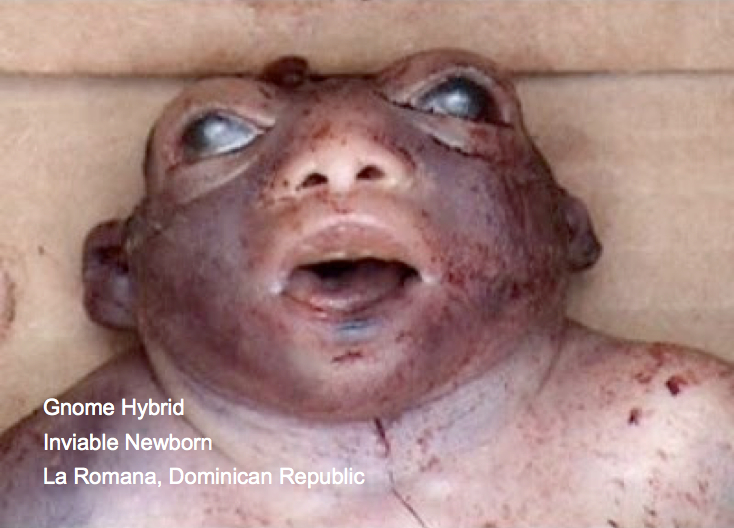
The extraordinary features presented by the newborn corpse closely correspond to the known gnome mummies from the US, displaying tiny stature, no visible neck or forehead, bulging eyes and unusually robust shoulders and arms. Cases of this kind are often hidden from the public to avoid family shame.

The same non-human physical characteristics can be observed of an inviable gnome hybrid baby born in the village of Charikot, Nepal in 2006 (above). The clear presence of gnome hybrid babies born among human populations attests to extraterrestrial hybridization trials that must surely have been identified by government geneticists tasked with sequencing these abundant specimens bearing non-human nuDNA.
Continue to Channeled Sources
Return to Nephilim Giants
From the book Baal Hybrids
Copyright 2015 Alexander Putney